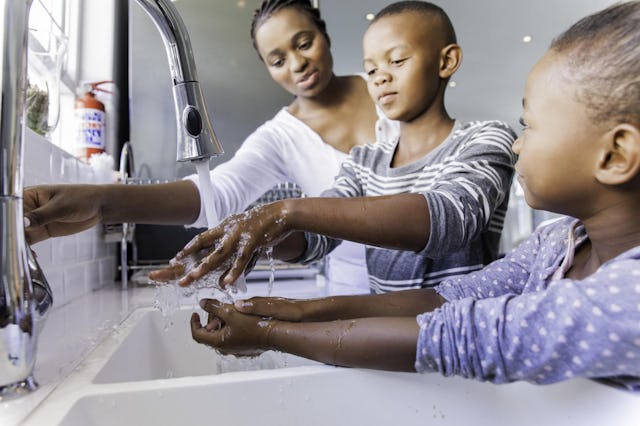We Don’t Have to Scare Our Kids Into Handwashing; Here Are 4 Ways To Make It Easier On Everyone

Over the last few months, children everywhere have had to learn to be experts at handwashing. Most kids learn the importance of washing their hands at an early age. I remember teaching my own kids.
In the beginning, I’d hold them in my arms, maneuvering their tiny bodies while I turned on the faucet. Later I graduated to supervising them as they stood on a step stool lathering up. Now we’re working towards getting to the point where I can send them off on their own, trusting they’ll come back with squeaky clean hands. But we’re not quite there, yet.
My kids understand they need to wash their hands after they go to the bathroom, and before they eat or touch anything in the kitchen. Teaching them that germs are everywhere and that hand washing should absolutely happen outside of those instances has been met with a bit of resistance. Since handwashing isn’t optional, I had to figure out how to make the practice easier on all of us.
Make it easy for them
Want your kids to wash their hands more frequently without fussing? Make sure it’s not a stressful experience.
If your kiddo is short, stick a step stool in the bathroom so they can reach the faucet without a lot of effort. Put a soap dispenser that little hands can use without your assistance, and make sure there’s a hand towel close.
You can keep a bottle of Hibiclens by your sink. Trusted for over 40 years by medical professionals, Hibiclens is gentle enough for tiny hands and begins killing germs on contact. With its iconic pink color — a throwback to its acute care history so nurses and doctors could identify it immediately — all you need is some water, a couple of pumps and a quick rinse.
Imagine if you had to find something to climb on, get help to use the soap, or search for a way to dry your hands. You’d probably be annoyed with it, too.
Talk about germs
A young boy grinning enthusiastically while washing his hands in the kitchen sink.
Once your handwashing station is good to go, the next step for a fuss-free handwashing experience is to talk to your kids about germs. You don’t have to scare them, just share information with them in a matter-of-fact way.
Tell your kids about what experts say, that things like restaurant menus and stair rails often have more germs than a bathroom. Explain to them how Hibiclens works to safely and gently bind to the skin, leaving a layer of protection.
When my kids realized the germs that make people sick are everywhere, they started washing their hands without me even asking.
Show them how it’s done
The first thing I do when I come in the house is take off my shoes and make a beeline to the bathroom to wash my hands. My children don’t just hear me telling them that washing their hands is important. They see me practicing what I preach.
It’s a lot easier to convince kids that something is good for them when they see it’s good for you, too!
Turn it into a game
We have a list of songs that we sing every single time we wash our hands. It’s so fun to belt out a Christmas carol in the middle of summer while we lather up.
Every once in a while let your kids use a little bit more Hibiclens than necessary to make pink bubbles in the sink*. Or give toys to play with in the sink for a few minutes after they’re done with their handwashing. Even though getting rid of germs is serious business, that doesn’t mean you can’t have fun while you’re doing it.
This article is sponsored by Hibiclens. Known for its iconic pink color and used in hospitals for 40+ years, Hibiclens is gentle enough for daily use1. Put a bottle next to every sink in your house for fuss free handwashing for the entire family! Click here for an exclusive $3 off coupon for Scary Mommy readers.
* Chlorhexidine Gluconate skin cleaners will cause stains if used with chlorinated products
1. PRACs Report #R05-0225
2. Paulson, Daryl S. Persistent and Residual Antimicrobial Effects: Are They Important in the Clinical Setting? Infection Control Today 2005; Vol 9, No 4.
3. 2012 Tork Report: The Sustainability Ga
This article was originally published on